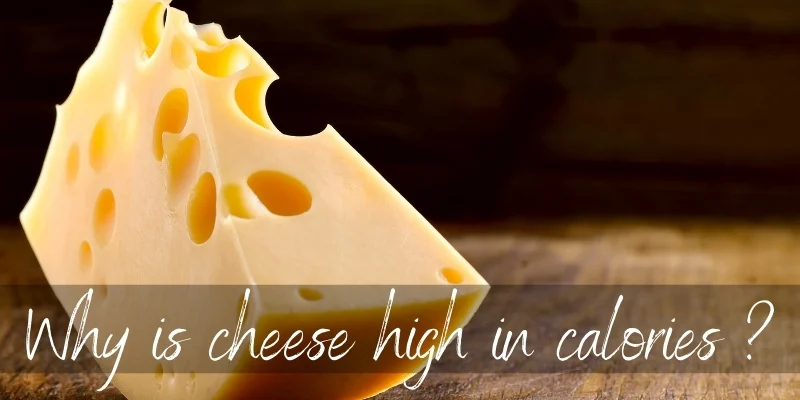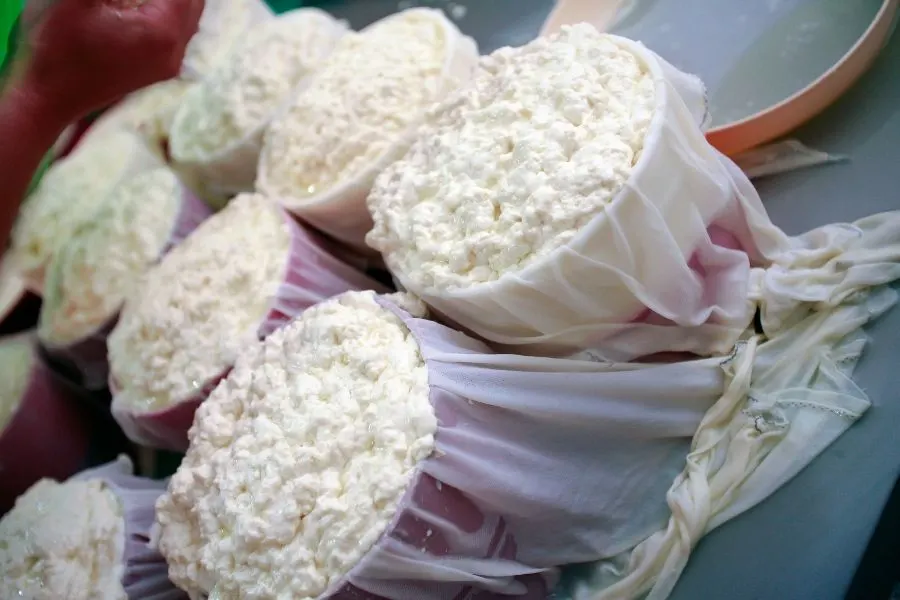So you absolutely love cheese but you’ve been told it’s fattening ? That’s okay, it’s possible that whoever told you that has your best interests in mind. But did anyone stop to explain just why cheese can be fattening, and so high in calories ?
Better yet, did anyone stop to talk about why cheese is made this way ? As with everything, a person’s health is a complex topic. Diet, physical effort, health issues, and daily habits are all a big part of how easily you may shed or gain weight.
Let’s clear this up: we’re not here to tell you to lose weight. We’re here to tell you why and how cheese has so many calories, and the decision is up to you. But it’s our duty to explain how calories work if you want to really understand what happens with cheese.

Why is cheese so high in calories ?
Cheese has a high amount of calories because it’s primarily made of fat, protein, and a little whey. There’s some sodium in there but that’s the gist of it. Fats have the highest calorie count, with 1 gram of plain fat containing 9 calories, and a gram of pure protein is 4 calories.
How each calorie is made up really depends on what the food is made out of. If you look at 400 calories of cheese, it will take up less space than 400 calories of oatmeal or tomatoes, because they’re built differently. Let’s take a look at how calories work, shall we ?
A short guide on how calories work
A calorie is simply a unit to measure the energy your food can give your body. Your body needs energy to be able to move, and based on your height, weight, and physical effort, you need a certain caloric intake to lead a healthy, active life. This intake may fluctuate, such as when you’re pregnant or breastfeeding, or going from rigorous exercise to a very sedentary lifestyle.
We’re not giving you ideal caloric intakes, you should discuss that with your healthcare provider. But for now, know that if your body ingests more calories than it can burn, this leads to gaining weight through fat.
The way calories work is that the food is transformed into glucose by your body. A certain amount is burned by the body in order to function and move, and the rest (if there’s leftover) is stored in the fat cells. The most amount of energy is taken from carbohydrates, like sugar, wheat, pasta, the lactose in milk, etc.
Read also: Can You Reheat Grilled Cheese ?
But what about cheese ? Cheese has a lower carbohydrate makeup, but higher fat and protein. The fats get turned into glucose too, much easier if they’re accompanied by carbohydrates. This is why donuts (wheat and sugar and oil) have a higher calorie count than plain bread.
There’s also fibers to take into account. A food high in fiber simply means it will take longer to digest, and the body has a more regulated intake of food to turn into glucose and then energy. Cheese has absolutely zero fibers and a high fat amount, meaning it gets turned to energy much faster. So your body is hit with so much energy at once, it has to either burn it all quickly, or store it somewhere.
This was a very short and rough guide on calories. This topic is better explained by a nutritionist or medic, but the basics are fairly easy to understand.
So you may now be wondering why cheese is made this way, if it can lead to weight gain so easily ?
Cheese needs fat and protein to form cheese curds
The answer is that cheese needs to be made this way. Or rather, it’s the only way to make cheese. You see, when the cheese curds separate from the whey, the protein and fats bond to make the curds.
A low fat milk cannot make stable curds, so it won’t be a very good cheese, and the cheese will break apart very easily.

The final product cheese is mostly fats and protein
This means that when cheese is made, matured, and then ready to be served, it’s mostly fats and protein. All the whey is drained from the curds when they are formed into cheese blocks.
And as the cheese matures, a good amount of whey evaporates and the percentage of fats and protein goes up, because the total volume of the cheese is smaller.
It’s also why aged cheese tends to taste saltier. As the whey (moisture) evaporates, you’re left with the plain nutrients and the amount of salt in the cheese is the same, but for less amount of cheese so it tastes saltier.
Is cheese fattening ?
In short, yes, cheese is fattening if you don’t burn the extra calories. It really depends on how much cheese you eat, because the extra effort needs to cover only the extra calories from the cheese.
If you’re trying to lose weight, cheese isn’t the way to go. A small amount here and there won’t hurt, but daily cheese intake and counting calories will not help. When you lose weight, you need to understand that you can sometimes mess up. You might be aiming to reduce fat, but end up reducing water weight or muscle mass, neither of which is the point.
A high fat diet will make it harder to lose fat, even if you’re in a caloric deficit to lose weight. You may be thinking of the keto diet. All we’re going to say is that it’s very difficult to have success with it, and even then the results are debated by medics.
Always take physical effort into account
How much physical effort you expend really matters. The body uses a lot of calories to perform basic functions like keeping the heart beating, breathing, thinking, digesting, and so on.
Then there are calories needed for it to move, walk, sit up and own. And on top of that, there are the calories used for more effort, like working out, of standing working a very run-here-and-there job, and so on.
It’s very easy to eat more than you use, because most foods that we take on the go are processed, have extra fat or carbohydrates to make it tastier, and we may end up with a meal that’s fattening instead of helping us maintain the weight and shape we currently have.
There are low fat cheese alternatives
But the biggest concern here was cheese, at least in this post. If you’re worried you may be eating too much cheese and can’t seem to shake the habit, you can always look for lower-calorie options.
Some options are fresh mozzarella, feta (high in sodium), cottage cheese, chevre. Finding truly low calorie cheese is difficult, because cheese needs a relatively high fat percentage to really hold together.
Tips on getting healthy cheese
You can find healthy cheese, but the larger point is that cheese, by itself, is not the problem. It’s just a small part of whatever you eat throughout the day. Total caloric intake per day, is more important than how many pieces of cheese you ate.
And what those calories are made is more important than how many calories you ate. A meal high in fiber and protein will be very filling and provide a lower amount of calories than something high in fats and protein that offers a similar calorie total.
For example, a grilled cheese sandwich packs a higher caloric punch because of the cheese, bread, butter and/or mayo. Compare it with a similarly sized whole-wheat bread sandwich with ricotta, arugula, and turkey. There’s less cheese, no butter or mayo, but there’s moisture form the ricotta.
On the whole, it’s lower in calories but also higher in fiber because it’s whole-wheat bread, and you’ve also got some leafy greens in there. Back to the point, let’s see what kind of cheese is healthier, or how to get a better cheese.
Go for unprocessed cheese
This is probably obvious, but always go for unprocessed cheese. By processed we men those packaged squares that we won’t name, or canned cheese, or the kind that says it has added wheat, added fat, added sugar, added anything.
A plain, simple cheese is always simple in ingredients.
Look for mild, low sodium, young cheese
A younger cheese has a higher moisture content, and when you cut into it, a piece will have less calories than a piece of aged, concentrated cheese.
So for example, 10 grams of young Cheddar is lower in calories than 10 grams of aged Cheddar.
Set a daily cheese limit
If you’re absolutely in love with cheese and can’ get enough of it, set yourself a daily limit. No more than a certain amount each day, and make sure to add in some vegetables, not necessarily meat or butter. This doesn’t mean you need to ditch meat or butter.
But for this particular meal, that as a lot of cheese, get yourself some good tomatoes, a dash of olive oil, fresh basil, and a couple of olives.
Read Also: What Is Spreadable Butter?
Watch the grilled cheese sandwiches !
This ties in with the above point, but try and limit the amount of grilled cheese sandwiches if you’re looking to lose fat. The bread, cheese, and butter are not helping, even in small amounts.

